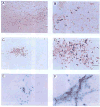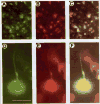General strategy for constructing large HSV-1 plasmid vectors that co-express multiple genes
- PMID: 11464513
- PMCID: PMC2581878
- DOI: 10.2144/01311dd05
General strategy for constructing large HSV-1 plasmid vectors that co-express multiple genes
Abstract
Herpes simplex virus type 1 (HSV-1) plasmid vectors have a number of attractive features for gene transfer into neurons. In particular, the large size of the HSV-1 genome suggests that HSV-1 vectors might be designed to co-express multiple genes. Here, we report a general strategy for constructing large HSV-1 plasmid vectors that co-express multiple genes. Each transcription unit is linked to an antibiotic resistance gene, and genetic selections are used to assemble large vectors. Using this strategy, we constructed large (26 or 31 kb) HSV-1 vectors that contain two transcription units and two or three genes. These vectors were efficiently packaged into HSV-1 particles using a helper virus-free packaging system. The resulting vector stocks supported the expression of two or three genes in both cultured cells and the rat brain. Potential applications of HSV-1 vectors that co-express multiple genes are discussed.
Figures



References
-
- Chung JH, Whiteley M, Felsenfeld G. A 5′ element of the chicken β-globin domain serves as an insulator in human erythroid cells and protects against position effect in Drosophila. Cell. 1993;74:505–514. - PubMed
-
- Fotaki ME, Pink JR, Mous J. Tetracycline-responsive gene expression in mouse brain after amplicon-mediated gene transfer. Gene Ther. 1997;4:901–908. - PubMed
-
- Geller AI. Genetic analysis of the role of protein kinase C signaling pathways in behaviors by direct gene transfer with HSV-1 vectors. Rev Neurosci. 1999;10:1–13. - PubMed
Publication types
MeSH terms
Grants and funding
LinkOut - more resources
Full Text Sources
